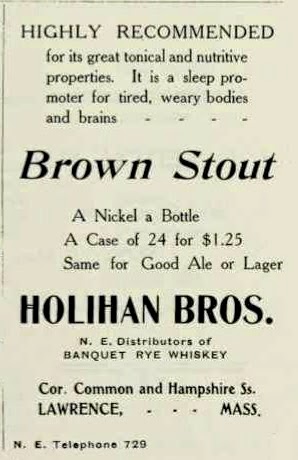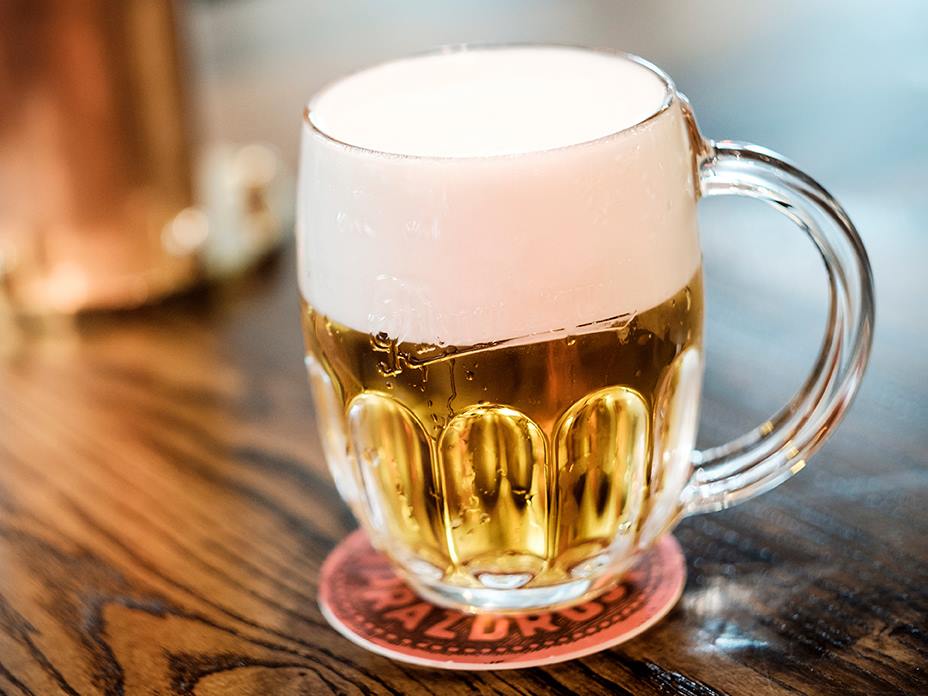|
Diamond Spring Brewery
Holihan Brothers of Lawrence, Mass. began as a producer of whiskeys in 1856. They operated the Diamond Spring Brewery from 1912 until around Prohibition and then opened after Prohibition in 1933. They produced beer and ales under the Holihan's and Diamond Spring labels. The company also made soda beginning in 1917. History Roots as a whiskey distiller The company was established in 1856 in Lawrence, Mass. by Patrick Holihan, a twenty-five year old Irish immigrant, and his brother Peter, as a grocer and liquor distiller, P&P Holihan a.k.a. Holihan Brothers. The liquor distiller was sold in about 1880 upon Patrick Holihan's death and ceased production, only to be bought by his three sons and reopened as a whiskey distiller. Their firm carried a general line of liquors, including two brands they claimed as proprietary, “Banquet Pure Rye” and “Old 56,” the latter presumably for the year their father and his brother had founded the business. Their facility was at 427 Com ... [...More Info...] [...Related Items...] OR: [Wikipedia] [Google] [Baidu] |
Lawrence, Massachusetts
Lawrence is a city located in Essex County, Massachusetts Massachusetts (Massachusett language, Massachusett: ''Muhsachuweesut [Massachusett writing systems, məhswatʃəwiːsət],'' English: , ), officially the Commonwealth of Massachusetts, is the most populous U.S. state, state in the New England ..., United States, on the Merrimack River. At the 2020 United States Census, 2020 census, the city had a population of 89,143. Surrounding communities include Methuen, Massachusetts, Methuen to the north, Andover, Massachusetts, Andover to the southwest, and North Andover, Massachusetts, North Andover to the east. Lawrence and Salem, Massachusetts, Salem were the county seats of Essex County, until the Massachusetts, Commonwealth abolished county government in 1999. Lawrence is part of the Merrimack Valley. Manufacturing products of the city include electronic equipment, textiles, footwear, paper products, computers, and foodstuffs. Lawrence was the residence of poet Robert Fr ... [...More Info...] [...Related Items...] OR: [Wikipedia] [Google] [Baidu] |
Pale Ale
Pale ale is a golden to amber coloured beer style brewed with pale malt. The term first appeared around 1703 for beers made from malts dried with high-carbon coke, which resulted in a lighter colour than other beers popular at that time. Different brewing practices and hop quantities have resulted in a range of tastes and strengths within the pale ale family. History Coke had been first used for dry roasting malt in 1642, but it was not until around 1703 that the term ''pale ale'' was first applied to beers made from such malt. By 1784, advertisements appeared in the ''Calcutta Gazette'' for "light and excellent" pale ale. By 1830, the expressions ''bitter'' and ''pale ale'' were synonymous. Breweries tended to designate beers as "pale ales", though customers would commonly refer to the same beers as "bitters". It is thought that customers used the term ''bitter'' to differentiate these pale ales from other less noticeably hopped beers such as porters and milds. By the ... [...More Info...] [...Related Items...] OR: [Wikipedia] [Google] [Baidu] |
Distilleries In Massachusetts
Distillation, or classical distillation, is the process of separating the components or substances from a liquid mixture by using selective boiling and condensation, usually inside an apparatus known as a still. Dry distillation is the heating of solid materials to produce gaseous products (which may condense into liquids or solids); this may involve chemical changes such as destructive distillation or cracking. Distillation may result in essentially complete separation (resulting in nearly pure components), or it may be a partial separation that increases the concentration of selected components; in either case, the process exploits differences in the relative volatility of the mixture's components. In industrial applications, distillation is a unit operation of practically universal importance, but is a physical separation process, not a chemical reaction. An installation used for distillation, especially of distilled beverages, is a distillery. Distillation includes the fo ... [...More Info...] [...Related Items...] OR: [Wikipedia] [Google] [Baidu] |
Brewery Buildings In The United States
A brewery or brewing company is a business that makes and sells beer. The place at which beer is commercially made is either called a brewery or a beerhouse, where distinct sets of brewing equipment are called plant. The commercial brewing of beer has taken place since at least 2500 BC; in ancient Mesopotamia, brewers derived social sanction and divine protection from the goddess Ninkasi. Brewing was initially a cottage industry, with production taking place at home; by the ninth century, monasteries and farms would produce beer on a larger scale, selling the excess; and by the eleventh and twelfth centuries larger, dedicated breweries with eight to ten workers were being built. The diversity of size in breweries is matched by the diversity of processes, degrees of automation, and kinds of beer produced in breweries. A brewery is typically divided into distinct sections, with each section reserved for one part of the brewing process. History Beer may have been known in Neolith ... [...More Info...] [...Related Items...] OR: [Wikipedia] [Google] [Baidu] |
Pilsner Beer
Pilsner (also pilsener or simply pils) is a type of pale lager. It takes its name from the Bohemian city of Plzeň (german: Pilsen), where the world's first pale lager (now known as Pilsner Urquell) was produced in 1842 by Pilsner Urquell Brewery. History Origin The city of Plzeň was granted brewing rights in 1307, but until the mid-1840s, most Bohemian beers were top- fermented. Originally called in german: Bürger-Brauerei Pilsen ( cs, Měšťanský pivovar Plzeň, en, Citizens' Brewery), it is now known as Pilsner Urquell Brewery. It was here they began to brew beer in the Bavarian style. Brewers had begun aging beer made with cool fermenting yeasts in caves ( lager, i.e., german: gelagert tored, which improved the beer's clarity and shelf-life. Part of this research benefited from the knowledge already expounded on in a book (printed in German in 1794, in Czech in 1799), written by Czech brewer (german: Franz Andreas Paupie, links=no) (1753–1805) from Brno. ... [...More Info...] [...Related Items...] OR: [Wikipedia] [Google] [Baidu] |
Stock Ale
Old ale is a form of strong ale. The term is commonly applied to dark, malty beers in England, generally above 5% ABV, and also to dark ales of any strength in Australia. It is sometimes associated with ''stock ale'' or, archaically, ''keeping ale'', in which the beer is held at the brewery. In modern times, the line has blurred between Old Ale and Barley wine. History Historically, old ales served as a complement to mild ales, and in pubs of the era typically the landlord would serve the customer a blend of the sharper stock ale with the fruitier, sweeter mild ale to the customer's taste. In London especially, the aged ale would take on a tart note from a secondary fermentation with brettanomyces yeast which was present either in the pitching yeast or in the wooden equipment. Because of the time required for the aging process, some investors would buy mild ale from brewers, age it into old ale, and sell it at the higher price. Eventually, brewers began to keep some beer behin ... [...More Info...] [...Related Items...] OR: [Wikipedia] [Google] [Baidu] |
Lager Beer
Lager () is beer which has been brewed and conditioned at low temperature. Lagers can be pale, amber, or dark. Pale lager is the most widely consumed and commercially available style of beer. The term "lager" comes from the German for "storage", as the beer was stored before drinking, traditionally in the same cool caves in which it was fermented. As well as maturation in cold storage, most lagers are distinguished by the use of '' Saccharomyces pastorianus'', a "bottom-fermenting" yeast that ferments at relatively cold temperatures. Etymology Until the 19th century, the German word ''Lagerbier'' ( de) referred to all types of bottom-fermented, cool-conditioned beer in normal strengths. In Germany today, it mainly refers to beers from southern Germany, either " Helles" (pale) or "Dunkel" (dark). Pilsner, a more heavily hopped pale lager, is most often known as "Pilsner", "Pilsener", or "Pils". Other lagers are Bock, Märzen, and Schwarzbier. In the United Kingdom, the term ... [...More Info...] [...Related Items...] OR: [Wikipedia] [Google] [Baidu] |
Porter (beer)
Porter is a style of beer that was developed in London, England in the early 18th century. It was well- hopped and dark in appearance owing to the use of brown malt.Dornbusch, Horst, and Garrett Oliver. "Porter." The Oxford Companion to Beer. Ed. Garrett Oliver. 2012. Print. The name is believed to have originated from its popularity with working class people and porters. The popularity of porter was significant. It became the first beer style to be brewed around the world, and production had commenced in Ireland, North America, Sweden, and Russia by the end of the 18th century. The history of stout and porter are intertwined. The name "stout", used for a dark beer, came about because strong porters were marketed as "stout porter", later being shortened to just stout. Guinness Extra Stout was originally called "Extra Superior Porter" and was not given the name "Extra Stout" until 1840. Today, the terms stout and porter are used by different breweries almost interchangeably ... [...More Info...] [...Related Items...] OR: [Wikipedia] [Google] [Baidu] |
Bock Beer
Bock is a strong beer in Germany, usually a dark lager. Several substyles exist, including: *Doppelbock (''Double Bock''), a stronger and maltier version *Eisbock (''Ice Bock''), a much stronger version made by partially freezing the beer and removing the ice that forms *Maibock (''May Bock''), a paler, more hopped version generally made for consumption at spring festivals. Due to its lighter color, it is also referred to as Heller Bock; from German ''hell'' (bright, light in color). *Weizenbock (''Wheat Bock''), a wheat beer made from 40–60% wheat History The style now known as ''Bock'' was first brewed in the 14th century in the Hanseatic town of Einbeck in Lower Saxony. The style was later adopted in Bavaria by Munich brewers in the 17th century. Due to their Bavarian accent, citizens of Munich pronounced "Einbeck" as "ein Bock" ("a billy goat"), and thus the beer became known as "Bock". A goat often appears on bottle labels. Bock is historically associated with speci ... [...More Info...] [...Related Items...] OR: [Wikipedia] [Google] [Baidu] |
Golden Ale
Pale ale is a golden to amber coloured beer style brewed with pale malt. The term first appeared around 1703 for beers made from malts dried with high-carbon coke, which resulted in a lighter colour than other beers popular at that time. Different brewing practices and hop quantities have resulted in a range of tastes and strengths within the pale ale family. History Coke had been first used for dry roasting malt in 1642, but it was not until around 1703 that the term ''pale ale'' was first applied to beers made from such malt. By 1784, advertisements appeared in the ''Calcutta Gazette'' for "light and excellent" pale ale. By 1830, the expressions ''bitter'' and ''pale ale'' were synonymous. Breweries tended to designate beers as "pale ales", though customers would commonly refer to the same beers as "bitters". It is thought that customers used the term ''bitter'' to differentiate these pale ales from other less noticeably hopped beers such as porters and milds. By the m ... [...More Info...] [...Related Items...] OR: [Wikipedia] [Google] [Baidu] |
Brewery
A brewery or brewing company is a business that makes and sells beer. The place at which beer is commercially made is either called a brewery or a beerhouse, where distinct sets of brewing equipment are called plant. The commercial brewing of beer has taken place since at least 2500 BC; in ancient Mesopotamia, brewers derived social sanction and divine protection from the goddess Ninkasi. Brewing was initially a cottage industry, with production taking place at home; by the ninth century, monasteries and farms would produce beer on a larger scale, selling the excess; and by the eleventh and twelfth centuries larger, dedicated breweries with eight to ten workers were being built. The diversity of size in breweries is matched by the diversity of processes, degrees of automation, and kinds of beer produced in breweries. A brewery is typically divided into distinct sections, with each section reserved for one part of the brewing process. History Beer may have been known in Neo ... [...More Info...] [...Related Items...] OR: [Wikipedia] [Google] [Baidu] |
Contract Brewer
A brewery or brewing company is a business that makes and sells beer. The place at which beer is commercially made is either called a brewery or a beerhouse, where distinct sets of brewing equipment are called plant. The commercial brewing of beer has taken place since at least 2500 BC; in ancient Mesopotamia, brewers derived social sanction and divine protection from the goddess Ninkasi. Brewing was initially a cottage industry, with production taking place at home; by the ninth century, monasteries and farms would produce beer on a larger scale, selling the excess; and by the eleventh and twelfth centuries larger, dedicated breweries with eight to ten workers were being built. The diversity of size in breweries is matched by the diversity of processes, degrees of automation, and kinds of beer produced in breweries. A brewery is typically divided into distinct sections, with each section reserved for one part of the brewing process. History Beer may have been known in Neoli ... [...More Info...] [...Related Items...] OR: [Wikipedia] [Google] [Baidu] |





_(cropped).jpg)
.jpg)

.jpg)

